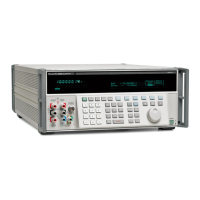5700A/5720A Series II Calibrator
Service Manual
5-40
3923 A5: 8255 Was Reset
The control word of the 8255 on the Wideband Output is read. A failure indicates the
Wideband Output (A5) assembly is probably at fault.
5-3. Component-level Troubleshooting
Warning
Servicing described in this section is to be performed
byqualified service personnel only. To avoid electricalshock, do
not perform any servicing unless qualified todo so.
The remaining part of Section 5 is devoted to troubleshooting the Calibrator analog
modules to the component level. Use the following information alongside the schematic
diagrams as a guide in troubleshooting if you do not wish to replace a faulty module
through the Fluke Module Exchange Program. (Refer to Section 1 for module exchange
instructions.)
Note
To access the Calibrator assemblies for troubleshooting during operation,
you will need the 5700A-7001K Extender Card Kit, Fluke P/N 857409.
5-4. Troubleshooting the Wideband Output Assembly (A5)
Proceed as follows to troubleshoot the Wideband Output assembly (A5):
1. Install the Wideband Output assembly on the extender card with its large right front
shield removed. The rear shield should remain in place. Connect a 50Ω load to the
Wideband Output at the type "N" connector on the Calibrator front panel. Power up
the Calibrator and call up the Wideband function.
Note
All measurements are referenced to SCOM (TP16) and all Calibrator
outputs are from the Wideband Option unless otherwise Noted.
2. Check the Oscillator input and the 10 Hz to 1.1 MHz Buffer circuit. Set the
Calibrator to 3.5V at 1 kHz operate. Using a DMM measure the ac voltage at TP9
and verify it is 7V ±10%. If a failure is detected, check input relay K1A and its drive
circuit. Next using a DMM measure the ac voltage at TP13 and verify it is also 7V
±10%. If a failure is detected, check U11B, Q17, K1B, K3B, K12, and associated
components in the 10 Hz to 1.1 MHz Buffer Circuit.
3. Check the Unity Gain Amplifier circuit. Set the Calibrator to 3.5V at 1 kHz operate.
Using a DMM measure the ac voltage at TP14 and verify it is 3.5V ±10%. If a failure
is detected, check Q11-Q16 and associated components is the Unity Gain Amplifier
circuit.
4. Check the RMS Sensor and Amplitude Control circuit during Wideband operation
below 12 kHz. Set the Calibrator to 3.5V at 1 kHz, operate mode. Verify that FETs
Q2 and Q3 are turned on by measuring the dc voltage at TP5. (It should be +17V
±10%.) If a failure is detected, check U4B and control line PB0. Using a DMM
measure and Note the ac voltage at TP7 and verify it is 7V ±10%. Measure the dc
voltage at TP1 and verify it is the same as measured at TP7 ±10%. If a failure is
detected, check U1, U2, U3, and associated components. Next measure the dc

